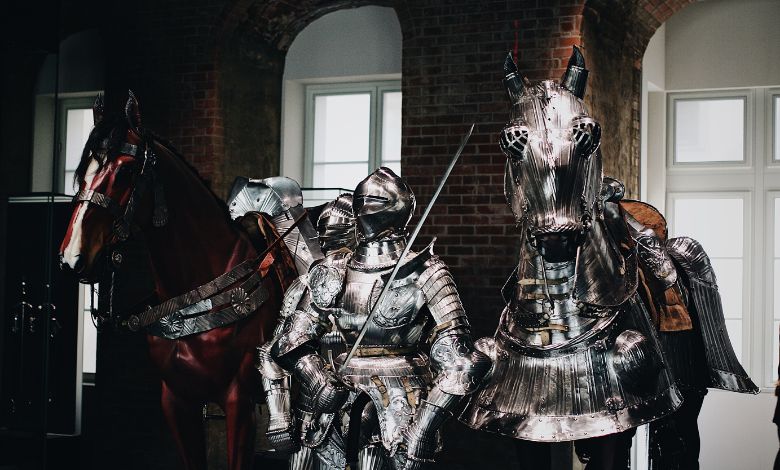Discover the legacy of the Nine Worthies, legendary heroes symbolizing courage, honor, and chivalry in medieval tradition.
Should you have ever come across medieval art, literature, or history, you may have come across an interesting moniker: the Nine Worthies. Though the Nine Worthies were quite real, at least in the Middle Ages’ cultural imagination, initially it sounds like something out of a fantasy book or a medieval-themed video game. Nine fabled leaders representing the values of chivalry, bravery, and honor, qualities that medieval knights and nobles yearned to reflect.
I first heard about the nine worthies in a dusty old history lesson, where my eyes glazed over as the lecturer hurried off names like Hector, Alexander the Great, and King Arthur. Actually, I thought, “Great, another list of old guys I’m supposed to memorize.” Then something clicked though. These were not just arbitrary heroes; they were a medieval “hall of fame,” the best models of virtue and bravery, motivating generations long before superheroes took front stage. That insight also piqued my interest to probe more.
In fact, exploring how these leaders were portrayed led me down other rabbit holes, like understanding autocratic leadership. where authority is centralized and command is absolute. Some of these worthies, especially the legendary kings and conquerors, would have thrived under such a model, or perhaps shaped it.
As we examine the nine worthies, I will guide you through history, myth, and culture in this essay. There is something here for you regardless of your interests, history, casual learning, or simply curiosity about medieval legends. Thus, get ready! Let us start right now.
Article Breakdown
Exactly are the nine worthies?
Celebrated in medieval Europe as the height of chivalry and knightly virtue, the Nine Worthies are simply a collection of nine heroic people from history, mythology, and religion. Usually split in three groups of three, they were:
- Three pagansthose without Christ
- Three Israelis
- Three devout Christians
Though strongly anchored in the Christian perspective of medieval Europe, this distinction was supposed to reflect a universal ideal of heroism that cut across theological barriers.
The following is the traditional 9 Worthies lineup:
The Three Paganism:
Known for his valour defending Troy,
- Hector of Troy is the honourable Trojan prince and warrior from Homer’s Iliad.
- Alexander the Great: Military master and Macedonian monarch who established among the biggest empires of the ancient world.
- Julius Caesar: Renowned for his political acumen, leadership, and military prowess, Roman general and dictator
The Three Jewers:
- Joshua: The Israelites’s biblical commander guiding them into the Promised Land.
- David: Renowned for conquering Goliath and his lyrical Psalms, the shepherd lad became king of Israel.
- Leading the Maccabean uprising against despotic government was the Jewish priest and warrior Judas Maccabeus.
There are three Christians:
- King Arthur: The fable British king, standing for justice and chivalry. King and emperor Frankish
- Charlemagne promoted Christianity and united most of Western Europe.
- Leader of the First Crusade and considered as a model of Christian knighthood, Godfrey of Bouillon
Why were the nine worthies so significant?
When you stop to consider it, this group of heroes was the ideal role models for medieval Europe, sort of like how modern society values superheroes like Superman or Captain America. Courage, honour, loyalty, and religion were among the traits people loved and aimed to reflect.
The Nine Worthies were originally mentioned in the poem Voeux du Paon (The Vows of the Peacock), by French poet Jacques de Longuyon in the fourteenth century. Following that, the idea permeated books, art, and even competitions where knights would dress as these leaders to exhibit their moral qualities. The simple fact that these valuables appeared in medieval contests represented the significance of their narrative to people of the period.
Personally, I enjoy how these heroes, b Pagan, Jewish, Christian, show a medieval endeavour, constrained by their viewpoint, to draw universal principles from many origins and stories. Heroes come in different shapes, as they were saying, and for the Middle Ages this seems really progressive!
Examining Each Worthy: The Medieval Hall of Fame
Let’s examine these people and find what distinguished them. I swear to keep it vibrant; there is no dull history lesson here! One
- Tragic Hero: Hector of Troy
Knowing full well you might perish, picture yourself as the bravest warrior protecting your house from invaders. That’s Hector. Hector is the honourable defender of Troy in Homer’s Iliad, fiercely resisting the Greeks. Hector’s humanity intrigues me; he is not only a brave soldier but also a loving spouse and parent. That harmonic mix between obligation and family seems ageless.
He is like that one friend that constantly defends you despite all the odds being against him. That devotion and bravery? Traditional heroic themes.
- Alexander the Great: Vision-Based
Conqueror Alexander’s tale is legendary material. Beginning as a youthful monarch full of dreams, by age thirty he had conquered much of the known planet. Alexander impresses me as having an almost unquenchable curiosity. He aspired to learn from all civilizations, share knowledge, and unite many people, not only about battle.
Consider him as the pinnacle go-getter, someone who never compromised for “good enough.” I recall reading about him in adolescence and experiencing a strange mixture of admiration and jealousy – how one person achieves so much before thirty?
- Statesman and Strategist Julius Caesar
Renowned general and politician Caesar turned Rome from a republic into an empire. Though he is sometimes shown as ambitious and sly, his leadership qualities are indisputable.
If you enjoy politics or strategy games, you will value Caesar’s skill in juggling military force with diplomacy. Real master of the game, he knows when to fight and when to bargain.
- Joshua: The Leader with Faithfulness
Following Moses’ death, Joshua guided the Israelites into the Promised Land. His narrative speaks of faith, discipline, and tenacity. Joshua’s life shows that trust in a greater good is equally important for leadership than mere strength.
I battled with difficult decisions in my younger years. Joshua’s example let me realize that faith and courage go hand in hand and that occasionally you have to be bold even if the road isn’t clear.
- David: King the Shepherd
From modest beginnings as a shepherd child to slaying the giant Goliath and rising to be king, David’s narrative is among the most inspirational in the Bible. With successes and setbacks equally, he is also a very human person.
David’s tenacity and inventiveness, he was a poet and musician as well, show that becoming a hero is about heart and soul rather than only about conquering conflicts.
- Judas Maccabeus: Rebellion Warrior
Leading a successful uprising against the Seleucid Empire, Judas Maccabeus sought to bring back Jewish worship and autonomy. He represents opposition and struggle for religious liberty.
In modern terms, he is that ardent activist who battles for their values against injustice regardless of the cost.
- King Arthur: The Great Legendary King:
Oh, King Arthur, probably the most well-known among the Nine Worthies. Arthur represents justice, chivalry, and the perfect leader whether or not he actually existed. For millennia imaginations have been grabbed by the tales of Camelot, the Round Table, and the search for the Holy Grail. For many, the King Arthur story reflects hope and justice in a turbulent society rather than only mythology.
Arthur’s story reminds me that sometimes the toughest conflicts arise inside; loyalty, honour, and honesty are the genuine missions.
- Charlemagne: European Empire
Emperor Early Middle Ages saw Charles unite most of Western Europe, proclaimed Emperor by the Pope. Promoting Christianity and education, he was dubbed “Father of Europe.”
I respect Charlemagne for his vision, not only to conquer but also to create a legacy of knowledge and culture. His narrative reminds me that actual leadership strikes a mix of wisdom and power.
- The First Crusade, Godfrey of Bouillon
rose to be the first king of Jerusalem upon its conquest. He represents Christian allegiance and knighthood.
While the Crusades are multifarious and divisive, Godfrey of Bouillon’s narrative in the Nine Worthies emphasizes medieval values of piety and valour. Among the nine worthies, his legacy is sometimes considered as serving as a link between earthly bravery and divine intent.
Why do the Nine Worthies matter now?
“Okay, these are cool stories,” you might wonder, “but why should I care in 2025?” The Nine Worthies do, however, reflect archetypes that still speak to us.
- Courage against the odds: Hector, David
- Vision and aspirations (Alexander, Charlemagne)
- Leading with faith (Joshua, Godfrey)
- honour and justice (Arthur)
- Resistance and fortitude (Judas Maccabeus)
- Strategy and clever (Caesar)
No matter your background, everyone can respect and aim for these attributes. Honestly, thinking back on these heroes amid trying circumstances has personally helped me to realize that heroism is about striving for better rather than perfection.
Nine Worthies in Art and Culture
Over the ages, the Nine Worthies have motivated innumerable musicians, authors, and painters. From Renaissance art to medieval tapestries, they were frequently shown as chivalry’s ideal. Before icons ever existed, these worthies were icons.
Keep a look out for murals or sculptures of these famous people should you ever visit a European castle or church. Indeed, some areas still carry the legacy alive by dressing as the Nine Worthies at mediaeval celebrations or contests.
Key Takings:
- Learning about the Nine Worthies has been a fascinating ride for me , from a dry history lesson to a personal inspiration. They’ve helped me see history not just as dates and facts, but as stories full of real human struggles and triumphs.
- If there’s one thing I want you to take away, it’s this: the Nine Worthies remind us that heroism comes in many forms. Whether you’re standing up for your family, leading a team, or simply trying to be a better person, you’re part of that same tradition of striving for honor, courage, and integrity.
- So next time you hear about the 9 worthies, you won’t just see a medieval curiosity , you’ll see a timeless reminder that we all have a bit of hero in us.
Additional Resources:
- Nine Worthies | Encyclopedia Britannica: An authoritative summary of the Nine Worthies, explaining their classification into three triads, pagan, Jewish, and Christian heroes, and their role as ideal figures of chivalry in medieval tradition.
- Tapestry of the Nine Worthies | The Met Museum: Explore this 15th-century French tapestry depicting the Nine Worthies, with historical context and analysis of how they were visualized in noble households and courtly culture.
- The Nine Worthies in Medieval Art and Literature | JSTOR: A scholarly article analyzing how the Nine Worthies were portrayed in literature and art, offering a deeper dive into their cultural significance and symbolic representation during the Middle Ages.



